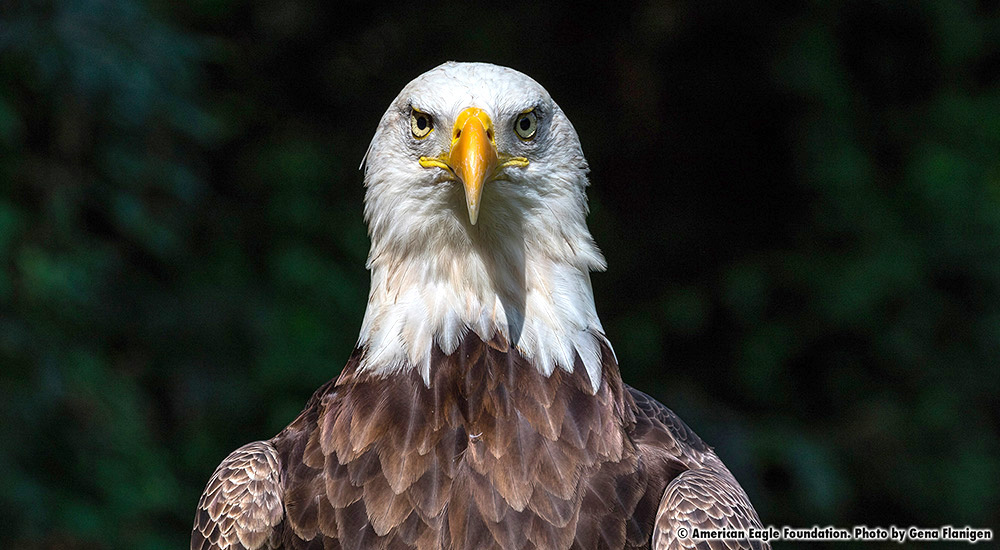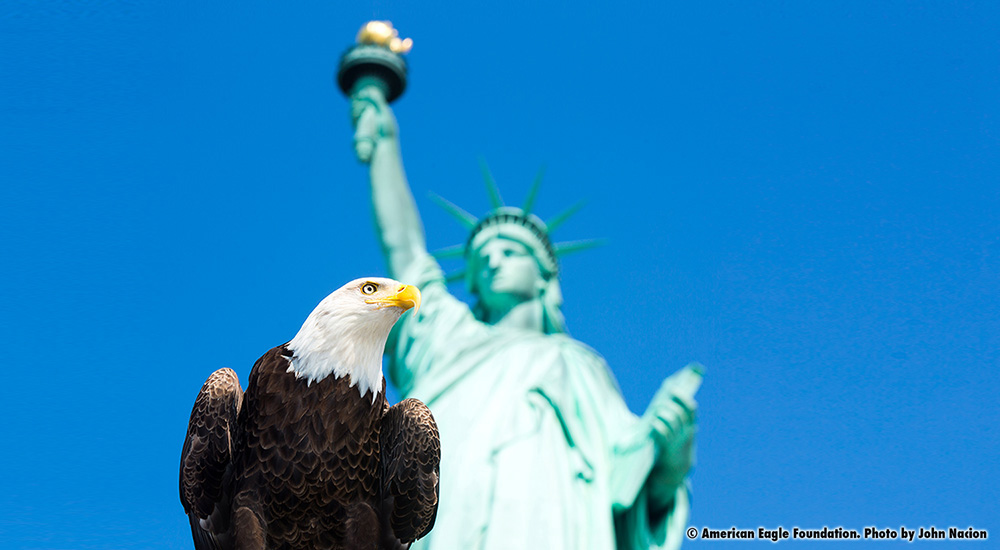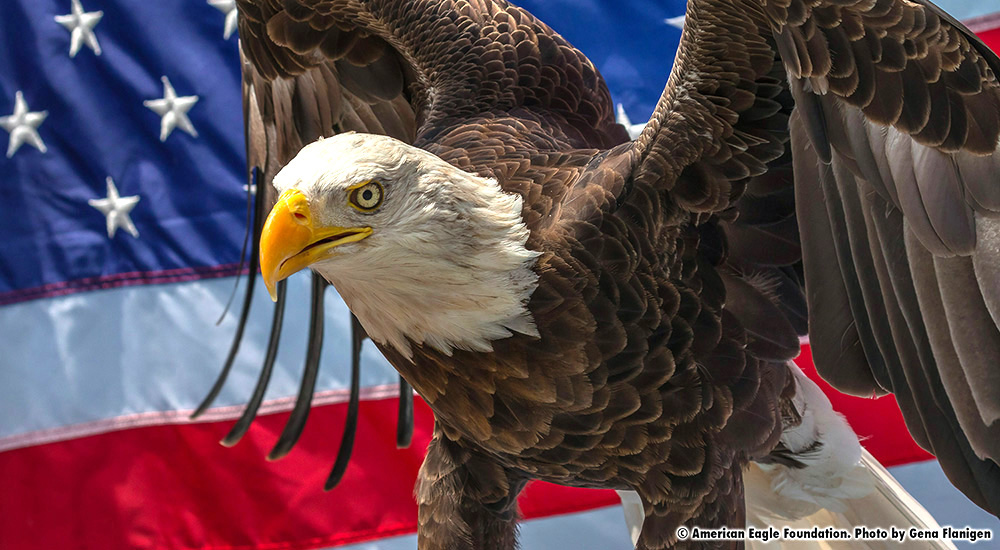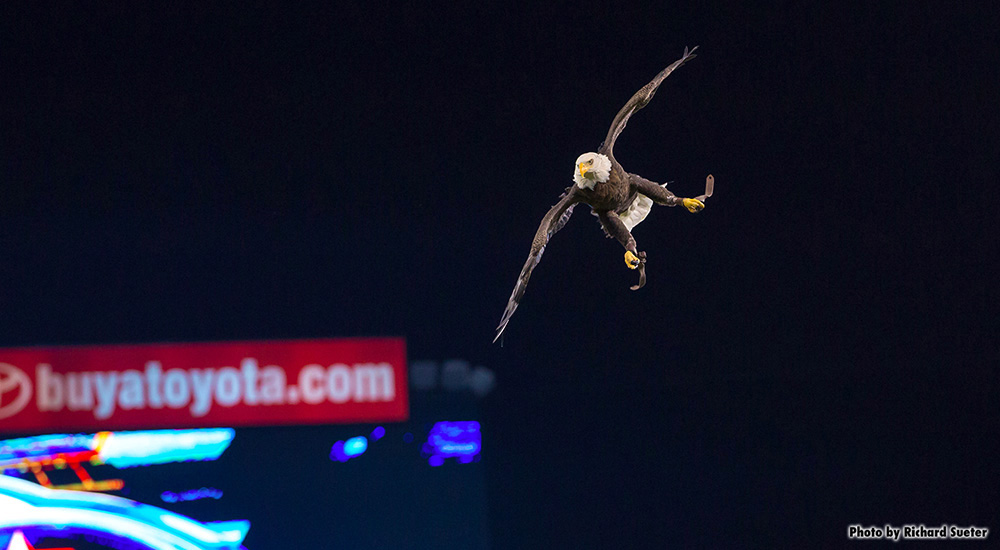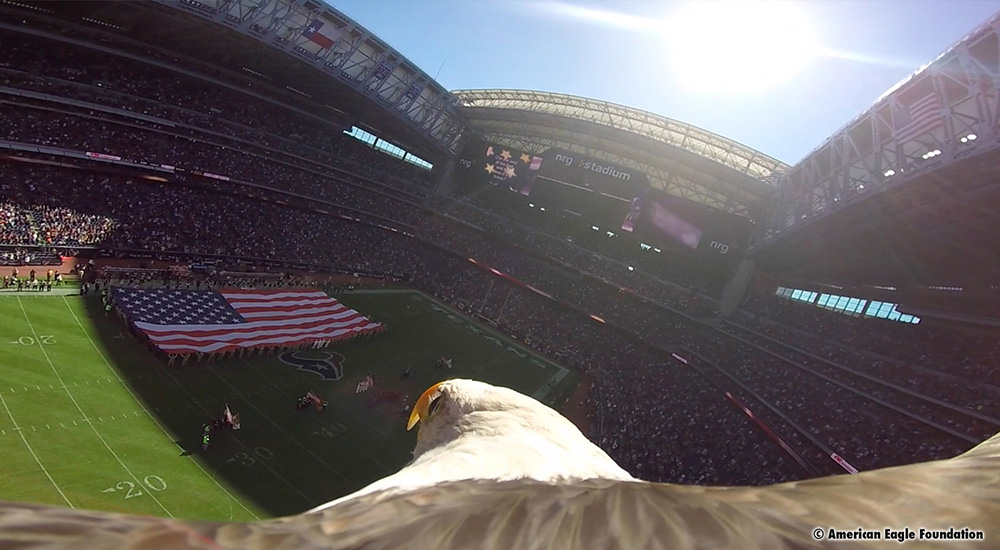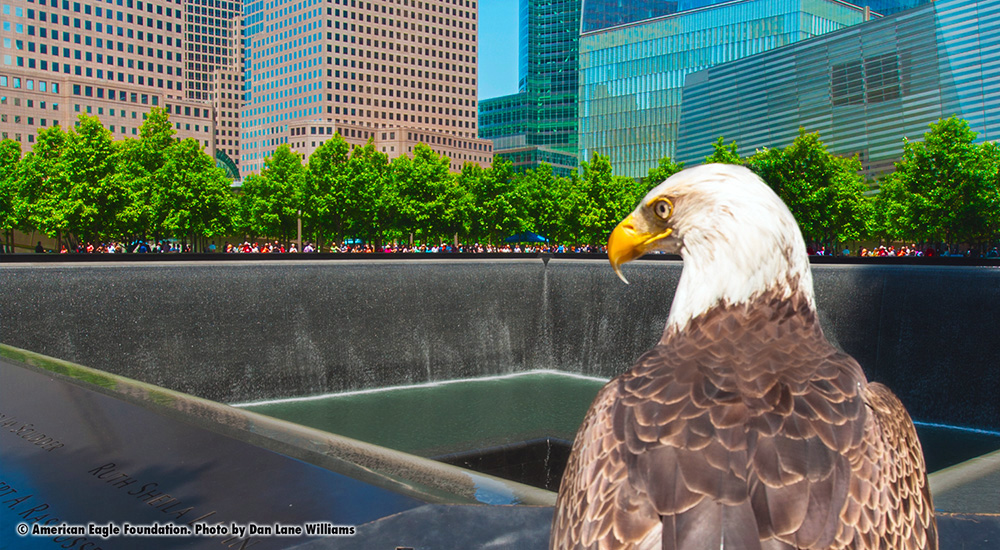CHALLENGER
Species: Haliaeetus leucocephalus, Bald Eagle • Hatch Year: 1989 • Sex: Male • Disability: Human Imprint
Challenger, The Most Famous Bald Eagle in America
In celebrating Challenger’s 36th birthday this year, AEF’s dedicated staff is committed to provide the most beneficial and healthy future for this eagle ambassador. Challenger retired from free-flighted appearances in 2019 but has continued to travel from coast-to-coast making gloved appearances at national sporting events, conventions, conferences, galas, fundraisers, schools, and other events. He is enjoying well-deserved rest & relaxation and continued daily flight exercise at his Tennessee home.
After 25 years of traveling coast-to-coast and in conclusion to one of Challenger’s most successful travel seasons in 2017, American Eagle Foundation would like to express our appreciation to the followers and fans of our famous Bald Eagle for their many years of support. Challenger has reached and educated hundreds of thousands of people nationwide, and has been instrumental in raising awareness about his species.
Soaring High & Flying Free, Challenger Has Inspired Millions
The crowd erupts into a loud roar! Challenger the Bald Eagle spreads his wings and soars through the stadium as a soulful rendition of the Star Spangled Banner in sung from the 50-yard line. He swoops! He circles! He dives! Suddenly the crowd grows silent as he makes his final descent. As the very last word of the National Anthem resonates throughout the stadium, Challenger gracefully lands on his trainer’s glove. Thousands cheer and wipe tears from their cheeks, touched by the sight of our living Symbol of Freedom soaring right before their eyes.
In the spring of 1989, a baby Bald Eagle (3-5 weeks of age) was blown from a wild nest in Louisiana during a storm. Fortunately, he was rescued by some well-meaning people who proceeded to hand-feed and raise him. Unfortunately, he experienced too much human contact at a very young age and became highly ‘human socialized.’
Challenger’s rescuers transferred Challenger to the Audubon Zoo of New Orleans. According to the records of the Alabama biologists, they picked up Challenger at the Audubon Zoo on June 8, 1989. At this time, they estimated his age to be about eight weeks of age (this means he most likely hatched between April 9-15, 1989. AEF therefore celebrates Challenger’s birthday around that time). They delivered him near Scottsboro, Alabama for hacking and later release on Guntersville Lake when first capable of flight at 12-13 weeks age.

Challenger was released twice into the wild that summer of 1989 and landed near people three different times in search of food. The first time was in Alabama near some fishermen and the second time was in a little league baseball field in Iowa, where he was found emaciated. Challenger was transported back to wildlife officials, where he was fed up and re-released. The young Eagle yet again landed near a man to beg for food, this time at Percy Priest Lake outside of Nashville, TN. The man was frightened, picked up a stick, and was about to hit the Eagle. Fortunately, another man intervened and prevented him from being harmed.
This being the third time the Eagle had sought out people to look for food when he became hungry, it was determined that he could not survive and hunt on his own in the wild. At that point, federal and state fish and wildlife agencies placed the Eagle in the care of American Eagle Foundation, which was headquartered in Nashville at this point in time.
AEF decided to name this Eagle ‘Challenger’ in honor of the fallen crew of the space shuttle.
 Challenger became a very well-trained gloved educational Eagle, used to educate people about the importance of protecting his species. Then one day AEF Founders and staff had a vision: what if we could train Challenger to perform dramatic free-flight demonstrations during the Star Spangled Banner?
Challenger became a very well-trained gloved educational Eagle, used to educate people about the importance of protecting his species. Then one day AEF Founders and staff had a vision: what if we could train Challenger to perform dramatic free-flight demonstrations during the Star Spangled Banner?
The rest is history.
Challenger became the first Bald Eagle in U.S. history trained to free-fly into major sports stadiums, arenas, and ballrooms during the National Anthem! Challenger’s first performance was the Bassmaster Classic in Greensboro, North Carolina in 1995. Some of his biggest appearances since then include five MLB World Series, Fiesta Bowls, NFL Pro-Bowls, BCS National Championships, NCAA Men’s Final Four tournaments, Disney’s Animal Kingdom grand opening, the Daytona 500, several Celebrity Fight Nights, White House appearances, Presidential Inaugurations, the Endangered Species Act Bald Eagle delisting ceremony, the Pentagon, U.S. Capitol Building, the World War II Memorial groundbreaking, NFL and MLB games across the US, and numerous national TV shows including Dateline NBC, Fox and Friends, Good Morning America, the David Letterman Show, and Larry King Live.
Challenger has performed over 350 free flight demonstrations at major league and collegiate sporting events, conventions, trade shows, and fundraising galas across the U.S., plus hundreds of additional appearances and flights at schools and veterans homes.
Challenger’s image is on a Tennessee specialty license plate and on specialty coins issued by the the U.S. Mint. No other specific animal has ever had its image placed on a coin minted by the U.S. Mint.
American Eagle Foundation is blessed to have been entrusted with this magnificent bird so many years ago. He has touched the life of millions upon millions of Americans across the country and he continues to daily touch the lives of his handlers. Challenger is truly one-of-a-kind. There will never be another like him.
ABOUT THIS SPECIES
Bald Eagles were placed at the center of the Great Seal of the United States in 1782! Since then, they have served as the pride of America’s skies and the symbol of all that America stands for.
Bald Eagles obviously aren’t bald! “Bald” in this sense refers to an Middle English word that means “white headed.” When eagles fledge the nest at between 10 and 13 weeks of age, they are primarily all brown. An Eagle gets its full white head and tail feathers and yellow beak and eyes at around four to five years of age.
Bald Eagles typically mate for life. Usually, they will only look for a new mate if their faithful companion dies, but sometimes a new mate is chosen in a territorial fight over a nest.
In building a nest, Bald Eagles will choose a ‘super-canopy’ tree—one rising above the rest— near to water, with sturdy limbs and a commanding view of the surrounding terrain. Typical nest heights are 50-125 feet high. They make use of twigs, grasses, soft mosses and feathers in making their nests and normally return to the same nest each year during breeding season and add new materials to it. A new eagle pair’s nest usually measures about five feet in width and two feet in depth. As they add to it year after year, however, it can reach widths of over ten feet and weigh up to a ton or more. On the Channel Islands, where large trees are very scarce, Bald Eagles have built their nests on cliffs; and, in some coastal areas of Alaska and Canada where there are few tall trees, Bald Eagles will nest on the ground, using whatever materials are available.

